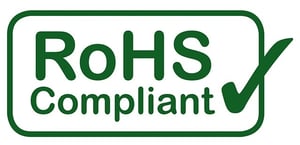Deadline Day: The RoHS 3 Directive Is Here
For those in the electronics manufacturing supply chain, RoHS compliance is a big deal. Hopefully you’ve treated it as such well in advance of the ...
5 min read
 Matric Group
:
Oct 15, 2024
Matric Group
:
Oct 15, 2024

The electronics manufacturing supply chain is a major risk for many OEMs. Challenges in this area include environmental and global regulations, which can be as confusing as the tangled cords behind your computer.
To cut costs and avoid delivery delays, working closely with your electronics contract manufacturer (ECM) is important for keeping components in your final product compliant with regulations. Since regulations affecting electronics manufacturers change often, both you and your suppliers need to stay alert. Not keeping up with these changes can lead to a series of problems that could impact you and several suppliers.
When you begin a new or redesigned project that requires extensive regulatory practices, you need to account for extra time, effort, and cost for your ECM. If you want your product to be sellable long-term, around the entire world, there’s no other way.
Consider what might happen if your product fails an inspection. If you’re audited, and your product doesn’t meet requirements, you could be fined. And it won’t be a slap on the wrist -- these penalties are designed to make it cost-prohibitive to ignore the rules.
Four regulatory areas are responsible for most electronics manufacturing supply chain compliance issues:
The aim of RoHS to limit hazardous materials, such as mercury, lead, cadmium and several others present in many electronic products.
 In America, some states have rules similar to this European Union-based mandate, but it’s not federal law. Still, if you want to sell your product in the EU, you must make certain that, if these materials are present, it’s in amounts under 0.1% (in the case of cadmium, 0.01 percent). Even if only part of your product has excessive levels of a RoHS material, the entire product will be banned.
In America, some states have rules similar to this European Union-based mandate, but it’s not federal law. Still, if you want to sell your product in the EU, you must make certain that, if these materials are present, it’s in amounts under 0.1% (in the case of cadmium, 0.01 percent). Even if only part of your product has excessive levels of a RoHS material, the entire product will be banned.
HOW YOUR ECM CAN HELP: Your ECM should know where the raw materials that go into your components come from and that they’re sourced with RoHS compliance.
Your contract electronics manufacturer can also help you assess the cost-effectiveness of releasing two versions of your products. It’s not unusual for OEMs to make a RoHS 2 compliant product for the EU market and a cheaper-to-make version for elsewhere.
Another EU regulation that is similar to the RoHS rule, REACH covers “substances of very high concern.” If a substance appears on the REACH list and is present in an amount higher than 0.1% of the product’s mass, you must report it.
HOW YOUR ECM CAN HELP: Just like with RoHS, your ECM should help you make sure nothing banned is going into your design.
The Dodd-Frank Act includes a section that requires public companies in the U.S. to demonstrate that the minerals they buy don’t benefit armed groups in the Democratic Republic of Congo or countries that adjoin it.
HOW YOUR ECM CAN HELP: Many manufacturers have a Dodd Frank policy outlining their adherence to a supply chain free of conflict minerals. It’s a bonus if your contractor uses a trustworthy third-party components database like SiliconExpert -- this can further help weed out gray market and counterfeit products.
The U.S. Food and Drug Administration monitors the Drug Supply Chain Security Act and the Unique Device Identification rule, which requires that manufacturers provide adequate information about the raw materials in their products. This information includes the raw material suppliers and shippers as well as how the final product is delivered to a distributor or retailer.
The FDA also has developed a little something called Title 21 CFR Part 11 to outline qualifications for record keeping. In practice, the rule means companies have to employ trained personnel who can document information.
FDA and ISO 13485 regulations are tiered in three groups/classifications.
Note that these are different from IPC class specifications for electronics.
Of utmost importance with medical devices is the term “off-label” manufacturing. The rule of thumb with the FDA is that you make what you say you’re going to make -- nothing more, nothing less. In other words, you can only sell a product or design that is approved within the regulatory specifications of the FDA. There’s a risk with certain email communications, approvals, etc. -- everything must be documented and archived properly.
HOW YOUR ECM CAN HELP: This FDA oversight has an especially big impact on medical device manufacturing. To make sure your product complies with FDA requirements, your ECM should either contract out the necessary record keeping or have the engineering capability to keep records on what goes into a medical product.
Records should go back at least 10 years. Sometimes OEM electronics makers demand record keeping for the product’s entire lifetime -- perhaps you should look into that. All this “paperwork” adds to the cost of the equipment, but it’s well worth the expense.
You need electronics manufacturing services providers who will watch your back, keeping you informed of evolving regulations and seeing to it that their own supply chain meets requirements.
If you want to avoid the pain that can come with non-compliance with regulations, pick your ECM based not only on its ability to provide you with functional components, but also on its regulatory knowledge. Your ECM is your source of information about what’s new and changing in the regulatory arena.
So ask about the regulations mentioned here. Test your ECM’s knowledge about conflict minerals and the subtleties of FDA watchdog processes.
The list above is not all-inclusive -- there are other ways your electronics contract manufacturer can help you stay in electronics regulatory compliance. To learn more about these processes, talk to your ECM early in the design phase.
Frequently Asked Questions About Electronics Manufacturing Supply Chains
How can OEMs proactively stay ahead of evolving regulations, especially if they operate in multiple countries with different standards?
Establishing an internal team focused on compliance or working with external experts helps interpret and adapt to new regulations. Early collaboration with ECMs is important, as they often have insights into regional requirements and upcoming changes. Regular audits of both internal operations and supply chain partners help catch any areas of non-compliance before they become issues. Ongoing education for teams and fostering relationships with regulatory bodies can provide early awareness of shifts in requirements. What additional costs should OEMs expect when meeting various regulations?Meeting regulatory standards often involves increased costs, including the expense of sourcing compliant materials and components, particularly when adhering to requirements like RoHS or REACH. OEMs may need to hire specialists in compliance or engage third-party consultants for audits and certifications, increasing labor costs. Record-keeping and documentation are additional operational expenses, along with any specialized software required to track compliance efforts. Changes to product design or manufacturing processes might be necessary, which could result in the need for new tools, equipment, or production adjustments, leading to higher production expenses. How do penalties for non-compliance vary across different regulatory bodies, and what are the most severe consequences for OEMs?Penalties for non-compliance differ depending on the regulatory body and specific violations. For instance, failing to meet RoHS standards in the European Union could result in product bans, preventing an OEM from selling in that market, along with substantial fines. Under REACH, non-compliance may lead to fines, product recalls, or restrictions on distribution. Violations of the Dodd-Frank Act regarding conflict minerals could lead to legal penalties, reputational damage, and scrutiny from investors. In the case of FDA regulations, especially in medical devices, non-compliance could lead to significant fines, product recalls, and in severe instances, legal action or restrictions on product sales. |
Navigating the maze of regulatory compliance in electronics manufacturing presents ongoing challenges for OEMs.
From RoHS and REACH to conflict minerals and FDA requirements, the regulatory landscape is complex and ever-changing. Success often hinges on the partnership between OEMs and their electronics contract manufacturers. Choosing an ECM with deep regulatory knowledge and robust supply chain management helps OEMs stay compliant, reduce risks, and remain competitive.
As regulations evolve, a proactive approach to compliance goes beyond meeting current standards – it positions your business for long-term success in the global market.
We have you covered. Download our free guide, “Electronics Manufacturing Compliance & Standards Guide” today!
This article was published in April of 2019 and was recently updated to reflect industry trends.

For those in the electronics manufacturing supply chain, RoHS compliance is a big deal. Hopefully you’ve treated it as such well in advance of the ...

When talking with salespeople, design engineers, and other contacts within an electronic contract manufacturer, you may hear a lot of terms thrown...

In 2006, the European Union rolled out a directive restricting the use of certain hazardous chemicals. This directive, Restriction of Hazardous...